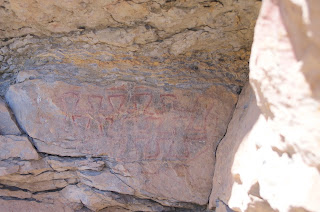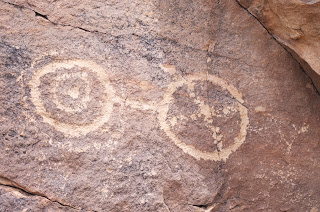Hembrillo Canyon
This was a special trip arranged for field trip leaders for the 2016 ARARA ( American Rock Art Research Association) Conference which was held in Las Cruces on Memorial Day weekend. The sites visited are on White Sands Missile Range and are not usually open to the public.
Hembrillo Canyon is a deep desert canyon in the San Andres Mountains. To the tops of adjacent peaks such as Kaylor and Treasure Mountains there is over 2000 feet of vertical relief. The canyon leads, from the east side of the range at a point almost 40 miles north of US 70, to Hembrillo Basin, the location of a battle between the US Calvary and Apaches led by Chief Victorio. It is also the site of the famous( infamous?) Victorio Peak, where one of the west's most well known lost treasures is, or was said to reside. At the very least its legend was born when a character named Doc Noss found a cave near its rocky cap. Whether the treasure is still there, was secretly removed, or ever actually existed remained a controversy throughout the second half of the twentieth century and to some perhaps to this day.
 |
| Victorio Peak |




The second site is on some cliffs along the south side of the streambed where there are cottonwoods and grapevine at the remains of an old sheep ranch.There are two panels with large human figures, some much older spirals and geometrics, and one stunning panel of miniature animals.
While both places were certainly of interest. There just wasn't a lot of rock art at either location. We weren't really allowed to explore either. So itchy as I always am for a hike, I ended up doing a lot of pacing up and down the sandy canyon.
It seemed to me the canyon itself was the real prize here, with wildflowers growing from cracks in the cliffs, and steep mountainsides of layer after layer of sedimentary rock. I've been in the San Andres Mountains three times now and it always seems like such a shame for the place to be off limits. The mountains, canyons and desert springs are the real treasure of this place and I ruefully wished I was free to explore the many secrets and unknown beauties of this long and narrow range.


Labels: petroglyphs, pictographs, scenic driving



































































